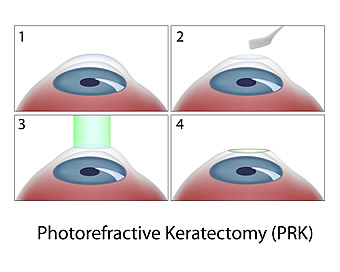Are you tired of relying on glasses and contact lenses? There’s a good chance you’ve already considered getting LASIK.
LASIK is the most popular vision correction procedure you can undergo. Why? It might have something to do with the procedure having a 96% patient satisfaction rate.
Most patients also end up with 20/20 vision or better. But LASIK isn’t the only vision correction procedure that’s available. There are alternative procedures if you don’t want LASIK or don’t qualify. These have comparable results and may be better for some patients.
While most people make good LASIK candidates, 10-15% of patients who get evaluated for LASIK don’t qualify. But for many of these patients, an alternative procedure is still viable.
If you’re worried about not qualifying for LASIK, read on to find out what makes a good LASIK candidate and what alternative procedure may be a better fit!
LASIK Qualifications

If you have a refractive error and need to use visual aids to see, you may be a good LASIK candidate. But what does a good candidate for the procedure look like?
Some factors include: being at least 18 years old and in good health with no pre-existing eye conditions. Your prescription should also be stable, meaning it hasn’t changed in at least a year.
A stable prescription ensures that your vision isn’t likely to change after LASIK, making it more effective. Keep in mind that these are only some factors that go into LASIK candidacy.
One qualifying factor for LASIK is impossible to determine on your own: how thick your corneas are.
During LASIK, your surgeon creates a flap in the cornea. After creating the flap, they lift it and reshape the tissue underneath.
Reshaping this tissue corrects refractive errors and provides you with improved vision. The flap is replaced and acts like a natural bandage to help your eye heal.
Your corneas must be a certain thickness to create a corneal flap safely. If your corneas are too thin, it can become unsafe to undergo LASIK.
Your pupils also can’t be above a certain size, or LASIK could adversely affect your night vision. These are factors evaluated during your LASIK consultation.
A LASIK consultation is the only way to know if you’re a LASIK candidate. Your surgeon can discuss LASIK alternatives if you don’t qualify for LASIK.
LASIK Alternatives
There are several surgical alternatives to LASIK. Your surgeon at New England Eye Center will discuss these alternatives with you to determine which one may be best for you.
Some procedures are suitable for people who don’t qualify for LASIK, but they may also be preferable for some patients, even if they do qualify for LASIK. Be sure to talk to your surgeon about all the options available to make an informed decision.
PRK

PRK is similar to LASIK because it uses a laser to reshape the cornea and correct refractive errors. However, unlike LASIK, there is no flap created in the cornea.
Instead of a flap, the outer layer of the cornea, called the epithelium, is scrubbed off. Then the procedure is performed directly on the exposed cornea.
Another difference between LASIK and PRK is that recovery from PRK may be more uncomfortable. Both procedures take about the same amount of time to recover after.
The epithelium grows back after a few weeks. During this time, your eyes will be protected by bandage contact lenses.
Although it may take a little longer, patients that undergo PRK experience almost identical results to LASIK, and over 95% of patients achieve 20/20 vision or better with PRK.
If you don’t qualify for LASIK due to corneal thickness, PRK may be a good option. But other options may suit you better, like the EVO Visian ICL.
EVO Visian ICL

The EVO Visian ICL is a procedure that inserts an Implantable Collamer Lens (ICL) into your eye. The EVO Visian ICL acts like a permanent contact lens that sits between your natural lens and iris.
The procedure is less invasive than LASIK or PRK, with an easy and fast recovery. It’s also popular for patients with dry eyes, as it’s made from a material called collamer.
Collamer is a naturally occurring protein in your body that makes the EVO ICL biocompatible and less likely to cause dry eyes.
The EVO Visian ICL is a good choice for patients who don’t qualify for LASIK due to corneal thickness or pupil size. But it also may be preferable for some patients who still qualify for LASIK because it’s fully reversible.
The EVO Visian ICL is the only reversible vision correction procedure. Both LASIK and PRK are permanent procedures.
Although the EVO Visian ICL is meant to be permanent, you can have it removed anytime. Many patients like this as an option because it makes having cataract surgery easier when you need an IOL to see clearly.
Unlike LASIK and PRK, the EVO Visian ICL only corrects nearsightedness and a small degree of astigmatism. It cannot correct farsightedness.
But there is another alternative for farsighted patients and patients with presbyopia.
RLE
If you suffer from presbyopia, LASIK is not the best vision correction procedure available. Presbyopia occurs when the natural lens loses flexibility due to aging.

As a result, you’ll notice it becomes more challenging to try to see things up close in front of you. Most people with presbyopia resort to reading glasses, but if you want to correct your vision, there’s another solution called Refractive Lens Exchange (RLE).
RLE is a procedure much like cataract surgery. It removes your eye’s natural lens and replaces it with an artificial one, called an IOL.
IOLs come in several varieties, with the ability to correct refractive errors—many also correct presbyopia. Choosing RLE is an excellent way to ensure you’ll never have cataracts later in life.
Instead, you can look forward to clear vision for the rest of your life. Even if you’re not considered a good candidate for LASIK, it doesn’t have to mean that you can’t correct your vision in another way.
Ready to find out the best vision correction method for you? Schedule an appointment at New England Eye Center in Boston, MA, to learn more!
